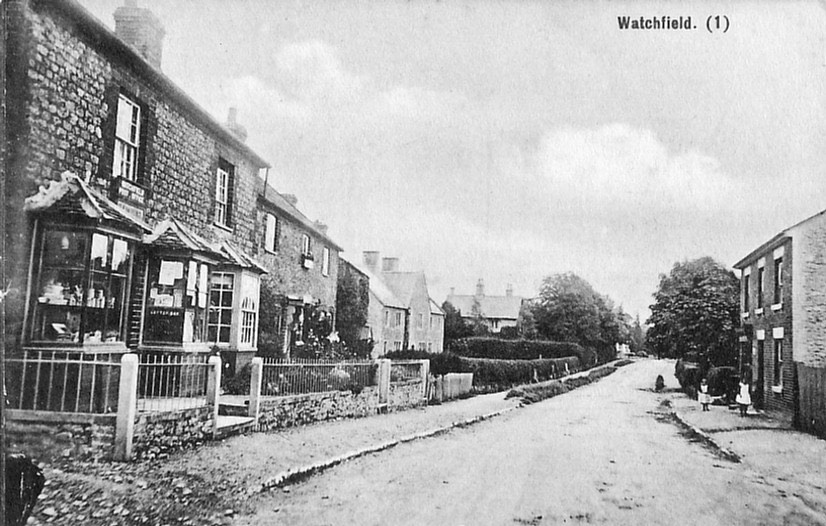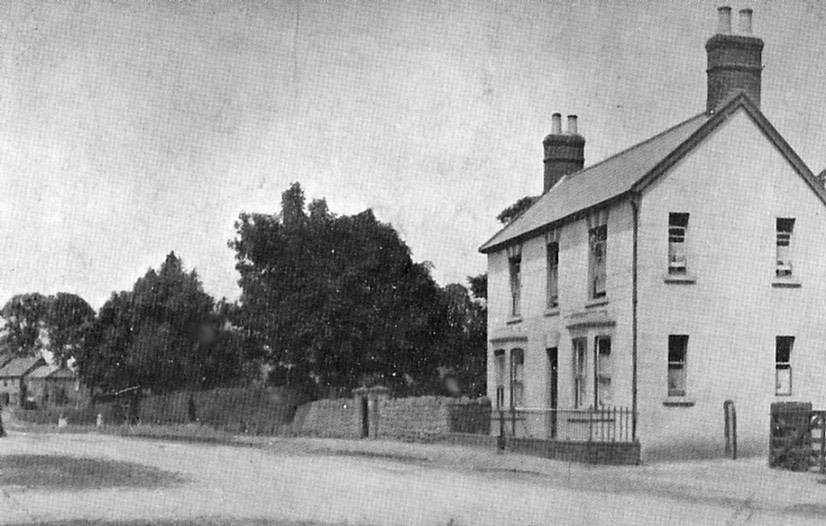Throughout the whole of the country, and probably more so in the villages, the Church held an enormous influence over the people. Huge numbers attended services and not only on Sundays but also in the week too. However, that tended to be seasonal with services curtailed in the harvest weeks due to long hours being worked in the fields. The Church played a major part of everyday life and, by today’s values, could be overbearing. We’ve already seen examples from the last century whereby parishioners were reported for sins of the mind and of the flesh and that continued into the 18th century. Once accused of sinful behaviour a miscreant was expected to make amends by demonstrating penitence publicly and a certificate would be issued stating what the penance should be. Below are some of them issued for Watchfield sinners.
BRO (M.F. 96249). Berks, Watchfield, the 21st day of April, 1700.
‘We the Vicar of Shrivenham and Chappell Wardens of Watchfield do certifie that William Watts of Watchfield and Edith his wife were this day being Sunday the one and twentieth day of April 1700 present in the Chappell of Watchfield all the time of morning prayer in their accustomed apparrell and there immediately after the reading of the second lesson standing up in the middle passage of the said Chappell where they might be well seen did pronounce and say after the Minister as followeth (viz)
"Whereas we William Watts and Edith Watts before we were lawfully married together forgetting our duty to God and the salvation of our own souls hath committed incontinency together. We are now heartily sorry for the same and do purpose and promise before God and you all here present that we (his Grace assisting us) shall from henceforth lead a Chaste and Godly life asking God and all others whom hereby we have offended forgiveness saying as our Saviour Christ hath taught us, Our Father .….."
Geo Stephens, Vicar of Shrivenham
William Young (his mark) Chappell Warden’
William Lawrence for Incontinency with his now wife, Margaret of Watchfield. Penance to be made in the Chapel at Watchfield 13 July, 1712. Certified by Geo Stephens, Vicar and Thomas Watts and Francis Hamblin, Chapel Wardens.
John Parsons and Sarah his now wife, sex before marriage. Penance to be made in the Chapel at Watchfield 16 December, 1713.
Penance of John Gyles of Watchfield for Fornication with Ann Young of Watchfield. Penance to be made on 5 April, 1725 in the Chapel at Watchfield. Certified by Stephen Fuller, Curate and John Young, Chapel Warden.
The Chapel Presentments due at the annual Visitation continued right through the 18th century and not only do they provide an interesting source of information about what previous inhabitants got up to, they also provide a list of Chapel Wardens through the Presentment period. Below are some of the more interesting ‘cases’ and I have included a list of Chapel Wardens mentioned within the documents at the back of this book.
BRO. D/A2/C132 Vicar, George Stephens, 16 April, 1722, presents William Robertson of Bourton and Anne his wife for Antenuptial Fornication. Also John Gering of Watchfield and Hanna Young of the same place, 'for cohabiting as Man & Wife when they will give no account of where and when and by whom they were married & also for Antenuptial Fornication before they are married.'
Vicar George Stephens, at the Abingdon Visitation on 10 April, 1727: ‘I present Mr Thomas Fairthorne of Watchfield and Mary Smith of the same for Fornication . They live now as Man & Wife together. I have seen no certificate of their marriage and when I referred to see one Mr Fairthorne told me the Clergyman who married him was dead, but if he is married yet Mary Smith had a bastard child by him born before marriage.’
In 1749 the Church Wardens, Thomas Anger and John Fairthorne make the first mention of the state of their Chapel which they say; ‘our Chappell out of repair.’ And this sets a steady trend and portrays the fact that the Chapel is crumbling.
On the 8 May, 1758 Church Warden, Thomas Simmons reports; ‘Our Chappell porch out of repair, but it is ordered to be repaired and is begun.’ And two years later the same man submits a similar report.
By the 1780’s the Chapel was obviously in a very poor state as one estimate, dated in September 1785, puts the cost of repairs to the value of £44.1.8. This amount was considered to be uneconomical as in the early part of 1788 a decision was made to demolish it. In a letter written by Edward Berens (who became Vicar of Shrivenham in Jan 1804) to Percival Walsh at the Registrar’s Office in Oxford, he refers to the bad condition of the Chapel which he describes as, ’falling down.’ Later he wrote in the Parish Register for Shrivenham; ‘1788. This year the Chapel at Watchfield was taken down by the order of the Bishop and consent of the Lord Chancellor, the Pastor of the Living. The Chapel was reported by six Commissioners to be of no very particular service to the parishioners of Watchfield on account of the vicinity of the Hamlet to the Mother Church. On taking down the Chapel the Timbers were found in so very ruinous and decayed condition, that it was the surprise of workmen it had not fallen down. It was certainly very ancient, the arches being the round Saxon arches.’
The last sentence of the previous paragraph is one that I’m sure will interest many people who have an interest in the history of Watchfield. It’s seems very likely that the core of this Chapel did in fact date from the Saxon period. Moreover, I would suspect that even if this was not the original, or first, Chapel, then it was highly likely the exact site of it. We know by the Willington map that the Chapel stood right in the middle of what is now the High Street, directly outside number 53A and Parsonage House. Just a few yards away there is a trackway that heads directly East towards Faringdon, passing the Folly and the ancient Saxon burial ground. This evidence makes this location then, a strong contender for the origins of the village, and it is with this in mind that the illustration, Picture 19, is based.
On 20 May, 1788, Church Warden, Barkley Wilson notes on the Visitation form; ‘The Chapel has been taken down by order.’ Similar words to those used above by Barkley Wilson continued for many years whereby the form had been filled in but references to the Chapel say, in one term or another, that it had been taken down. However, on 26 May, 1803, Church Warden, Henry Gearing wrote; ‘the Chappel taken down in the year 1788 and the Ground exposed to the Village.’ And on 12 May, 1806, he wrote; ‘the Chappel sold and taken down in the year 1788 and the foundation exposed to the Village.’ So it would seem that the foundations of the Chapel were perhaps held in some veneration by the villagers.

Picture 30 (above), is circa 1910. The old chapel stood just where the road rises in the distance, adjacent to Parsonage House.

Picture 31 (above), is slightly earlier at 1905. The old chapel stood in the middle of The Street by the trees and the road passed either side. (See Willington map on Key Page) The premises on the right was known as Lilemore Cottage. Both pictures above Courtesy of Paul Williams

Picture 32 (above). The Chapel taken down in 1788 stood in the High Street in front of Parsonage House. (See Willington Map on Key Page). The Chapel Presentments refer to Parsonage House in the 1780’s and I suspect that the wall standing there today (lower centre in picture) is the original boundary.
The demise of the old Chapel did leave a legacy in the form of £189.6.0 realised by the sale of the materials as it was dismantled. This money would eventually assist in the building of the new Chapel 70 years later, but its course through that time was not straightforward as a document from the archives clearly shows and makes interesting reading: (WRO D/1/24/330/8) ‘The money arising from the sale of the old material of the Chapel, was vested in the purchase of 3% Consols in the joint names of the Hon Rt Rev Shute Barrington, Lord Bishop of Sarum and the Rev Barfoot Colton, Vicar of Shrivenham. The Dividends upon the said Stock appear to have been received under a Power of Attorney from the Trustees and from time to time applied to the purchase of linen and other necessities for the poor of Watchfield. Thus it appears by the Chapel Book (Nov 23rd, 1794) that Mr Colton paid £40 (being £39 and £1 in interest) to be given in clothes and reduce the price of wheat again £15.12 to Jan 1796 in fuel and linen; and again £22.10 being three years interest to October 30th, 1799 to reduce the price of bread. Mr Colton died in December 1803. Some time in the summer of 1804 the subject was mentioned to Mr Berens (who succeeded Mr Colton as Vicar) by some of the inhabitants of Watchfield, and he accordingly after some communication received from Mr Colton’s executors the money due on the time of his death. Mr Berens stated to the Parishioners of Watchfield assembled in Vestry, his opinion, that as the money proceeded from the sale of the materials of a building dedicated to the service of Religion, it ought to be still employed in the advancement of Religious knowledge, and proposed that it should be applied to the establishing of a Sunday School for Boys and another for Girls. One respectable farmer wished the money to be applied to the apprenticing of poor children; but the majority acceded to the Vicar’s suggestion. The schools continued for some years. At length, the Sunday Schools declined and more ultimately given up. For some years Night Schools were tried, and a few children occasionally paid for on the day school. In the year 1815 or 1816 John Dixon Esq came to reside in Watchfield House. His active benevolence led him to pay much attention to the Sunday School which was established on the Chapel Account and several children were also placed on the Day School. As there was but little room in Shrivenham Church for the poor women and children of Watchfield, Mr Berens thought that some of the Chapel money might be applied advantageously in providing seats for them. A Gallery was accordingly built with the consent of the Bishop of the Diocese, the two back seats in which were allotted to the singers upon their giving up to the poor of Watchfield; the seat (larger in size) which they (the singers) formerly occupied in the body of the church. A shared back seat in the Gallery, that to the North West was also paid for out of the Chapel money and let at a guinea per annum for the benefit of the school.
After Mr Colton’s death the Dividends upon the Stock continued to be received (under Power of Attorney) by Dinsdale & Co, London, and paid by them and Mssrs Bowley, Ogden & Wyndham, Barkem in Salisbury, who declined paying the money excepting to Mr Colton’s Executors or to the Bishop of Durham. Mr Berens accordingly wrote to both. The Executor referred him to the Bishop of Durham. The Bishop professed his readiness to do whatever was right, but conceived that having long since ceased to be Bishop of Salisbury, in which capacity he had become a Trustee, he had now nothing to do with the money. This occasioned some delay, and in the meantime Messrs Bowles, Ogden & Wyndham became Bankrupt. Mr Berens wrote to them in behalf of the inhabitants of Watchfield requesting that attention might be paid to their claim, as well as to that of the other creditors of the firm but no answer was returned to his letter, and he had no legal power to enforce the claim. The Dividends of several years were accordingly lost.
The Dividends from 3rd January, 1810 to 5th January, 1814 were received by Messrs Barnard & Dinsdale and by them paid to Mr Berens to the order of the Bishop of Durham. In 1817 the Stock was transferred to new Trustees, viz, the Lord Viscount Barrington, John Blagrave Esq proprietor of Watchfield House, and the Rev E. Berens, Vicar of Shrivenham, who signed a declaration of Trust purporting that the interest of the Stock was to be applied to the Instruction of the Poor Children of Watchfield at the discretion of the Vicar for the time being.’
With the Chapel gone, the various goods belonging to it had to be put to use, and this prompted the Churchwardens at Shrivenham to carry out a tally of their goods, followed by the goods they had received from Watchfield. It may be as well to include that part of the list here:-
(BRO MF & SHS N359. P.36)
An Account of Church Goods as they were then, by us Henry Gearing and William Wright, Church Wardens, 1788.
Goods brought from Watchfield Chappel
One Bible of the Largest Volume
Two Books of Common Prayer
One Silver Waiter on a Stand
One Pewter Flaggon
One Pewter Plate
One Pewter Bason for Baptisms
One Holland Table Cloath
One Holland Knapkin
One Surplis
One Striped Table Cloath